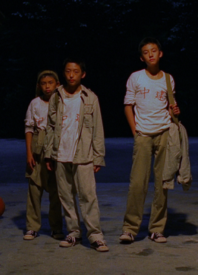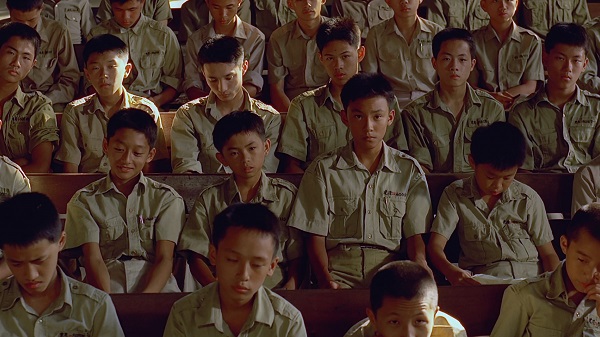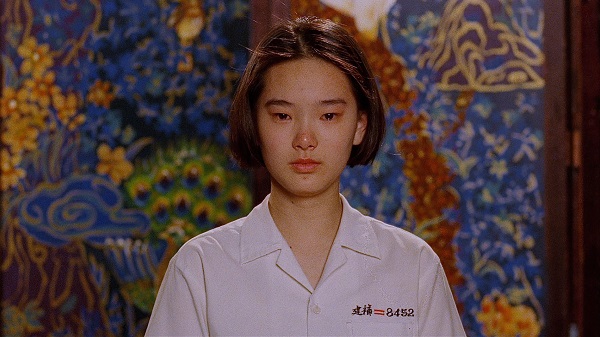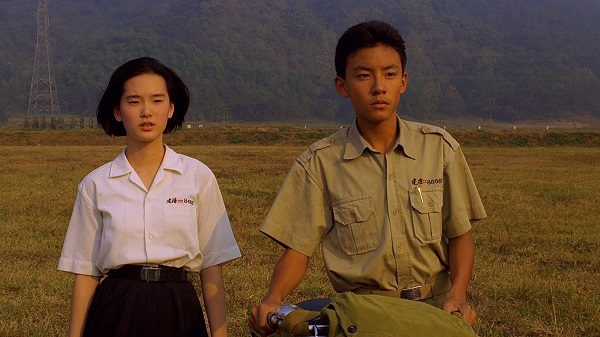
What immediately stands out when one hears about Edward Yang’s magnum opus A Brighter Summer Day for the first, is the film’s elephantine length. Clocking in at just under four hours, the film is a long one; one of those white whales that every cinephile mentally adds to a bucket list for no reason other than to simply say that you’ve seen it. It goes on this list alongside films such as Sátántangó, Tie Xi Qu: West of the Tracks, Akerman’s Jeanne Dielman, and pretty much the entire collected works of Lav Diaz.
Yang would only ever work in the epic frame of length two other times; the equally revered Yi Yi and his debut feature That Day on the Beach. Even then, A Brighter Summer Day is a full hour longer than the concluding chapter in the Taiwanese master’s filmography. In terms of sheer temporal scale, it is an aberrant vision.
It is also an aberrant vision in terms of subject matter as well. Partially spurned on by the success of colleague and friend Hou Hsiao-hisen’s landmark A City of Sadness, A Brighter Summer Day is a period piece. The film deconstructs the time period of Yang’s adolescence; a Taipei of the early 60s in the throes of martial law, under a Kuomintang (KMT) government desperately clinging to the dimming possibility of retaking the mainland. It is partially based off of Yang’s memories, with the film’s original Chinese title directly translating to The Homicide Incident of the Youth on Guling Street, referring to a grisly and infamous moment from Yang’s youth.
A Brighter Summer Day is the only period piece in Yang’s filmography. The rest of his output consists of varying forms of city melodrama, with the chief theme routinely interrogating the fracturing of relationships in a rapidly mutating Taipei. As previously mentioned, Yi Yi is probably Yang’s most well-known film, if only because it’s early 2000s American release primed it to be referenced on innumerable best of the decade lists. It deserves all the praise it gets, but so too do the lesser known Yangs. I have a soft spot for A Confucian Confusion, a dryly humorous lampooning of early 90s yuppie culture, where business deals are always conducted in a TGIFridays, or in front of cavernous projector screens loudly emitting whatever the NBA on TNT game of the week is. Maybe the best space to start with Yang is The Terrorizers, a film that was immortalized by postmodern cultural scholar Fredric Jameson in his landmark text The Geopolitical Aesthetic. It is the condensation of Yang’s dizzying multi-valent plotting into an explosive hour and fifty-minute package.
Or, you could start right here with A Brighter Summer Day, which might be the easiest film to track down at present due to its recent enshrinement into the Criterion Collection as part of Martin Scorsese’s World Cinema Project. If you’re going to start here, you probably need a bit of a history lesson first though. Taiwan is an island nation off the coast of Mainland China. In the late 1940s after the defeat of the nationalist KMT to Mao’s communists in the Chinese Civil War, many mainlanders fled to the island. From here, the KMT led a society clouded by a fog of unease, and maintained a policy devoted to the eventual recapturing of the mainland. The youth who grew up in this time period experienced a clouded future. Many of them were participants in street gangs. This much is provided to you in the form of a title card at the outset of the film’s opening moments.
Yang is of course, one of these children. His main protagonist is Xiao Si’r (Chang Chen), a nickname meaning “little four,” as he is the fourth of five children. Paolo is under the impression that he could beat-up this teenage version of Chang Chen. Si’r is a bit of a rebellious youth. Our introduction to who he is involves his father begging to revoke his son’s expulsion from a daytime school. He is unsuccessful, and Si’r is transferred to night classes, which most of the more rebellious youths end up.
Months later, Si’r and his friend Wang Mao (Wong Chi-zan), who is appropriately nicknamed Cat, sneak onto the set of a local film production. In the attempted escape, Si’r is caught, but a distraction provided by Cat allows him the opportunity to flee without repercussions. Si’r grabs a flashlight on the way out, and shines it upon two young lovers kissing under a tree. One is Sly (Chen Hong-yu). He female counterpart is easily discernible. While her identity may seem inconsequential on paper, I can assure that it is ultimately anything but inconsequential.
In fact, Yang’s cinema is a cinema of details. Rarely is a detail ever inconsequential. What makes his work pop is that he is often juggling multiple story lines all at once, that intersect in the most impactful of ways. In A Brighter Summer Day Alone, there are at least five main story lines. Si’r’s may be at the forefront, but just as important is the plight of his father (Chang Kuo-chu, Chang Chen’s real life father), a bureaucrat who struggles to protect his children. Or any of the other stories for that matter. A Brighter Summer Day is about a seismic shift in Taiwan, wherein outside influences and geopolitical realities have begun to dramatically reshape life on the island.
Some are more affected than others. The film’s English language title stems from a mistranslated Elvis lyric, summer substituted for sunny in this case. It’s Cat who begs Si’r’s elder sister to help him the translation. All the young man wants is the opportunity to croon the King. It’s a desire indicative of the progressing Westernization of the island’s youth, who wear white t-shirts and blue jeans, and listen to rock-n-roll and doo-wop on large wooden radios. Many scenes take place inside a Western style parlour. It’s where Cat first gets his opportunity to sing.
Unlike Hou’s A City of Sadness, which won the 1989 Venice Film Festival en route to being one of the most domestically successful films of all time, A Brighter Summer Day struggled to get released and few saw it. In an essay the director penned for the 1991 Tokyo International Film Festival, Yang alluded to the fact that “the Taiwan film industry has all but collapsed over the past three years.” I wonder if he knew how right he was. A City of Sadness was ostensibly the end of the Taiwanese New Cinema, a cinematic wave of young filmmakers with fresh ideas, of which Hou and Yang were the most prominent members of. A flagging box office and accusations that Yang and his counterparts had capitulated the tastes of Western art house audiences at the expense of the domestic ones, pretty much halted whatever progress had been made over the course of the decade.
The fact that Yang made his epic with such little support would probably be more astounding if it weren’t simply par for the course. Hou starred in Yang’s second feature Taipei Story, and the star supposedly mortgaged his house to help pay for the production. The magnificent Yi Yi was never seen in Taiwan, as after one too many spats with local officials Yang refused to release the film domestically. That he made all of the art he did while fighting the system is a testament to the directors’ capabilities.
For as unique as A Brighter Summer Day is, it still contains many similarities to Yang’s other films. The dense plotting is the most obvious one, as few directors would choose to make the emotional climax of their four-hour film a call-back to an innocuous sound bite from the film’s opening salvos. The idiosyncratic composition delightfully remains another authorial touch Yang continues here. Many shots are taken from outside rooms, with people partially blocked off by walls. There’s a particularly East Asian cinematic touch to the composition of the frame in Yang’s work. It’s an explicit form of compartmentalization, in which people are routinely separated.
It’s the historical aspect, however, that makes A Brighter Summer Day what it is. It is not just the pop cultural details that are afforded importance in this, but also, some of the more disturbing elements. One scene involves a series of tanks rolling through the city. The characters within this world pay them no heed; presumably, it’s a regular occurrence resulting from martial law. In another instance, Si’r’s father is arrested and imprisoned, where he is forced to confess to a crime he did not commit. It’s a harrowing moment that is indicative of the White Terror inflicted on the citizens of Taiwan by the KMT.
Yang’s determination to display the history that he remembers plays into the film’s thematic impulses. Ultimately, the film contains a motif of light and dark. The very first shot of the film features a light bulb being turned on, illuminating the darkness. Si’r shines a light into trees. He is unprepared for what he sees. Perhaps A Brighter Summer Day is Yang’s attempt to illuminate the darkness of Taiwanese history, to lay bare the realities of traumatized youth unable to be protected by their traumatized parents, all of whom must exist on an island heavily bearing the scars of said trauma. Where those you love could be forcibly abducted by the government in the middle of the night without an explanation as to why. You’d never get one if you asked.
As distinctly Taiwanese as this film is, the chief question posed by Yang is one that is universal. He asks us how well we know our history. If we were to extrapolate this to a more universal setting, I would guess that we don’t really know such things. Land acknowledgements are a part of every major Canadian event nowadays, and will continue to be so when those start up again. For those who do not have to think about it, that’s very much their only recognition of such moments. For those who have to think about it, it’s every waking moment of every day.
In what might be one of the most beautiful reviews ever written, Walter Chaw uses A Brighter Summer Day as a eulogy of sorts for his uncle who was one of the key influences on his life. Thematically, it fits with the fact that Yang supposedly dedicated the film to his father. I am nowhere near the gifted communicator that both of those geniuses were and are, but may I suggest these sentiments touch upon one of the many magnificent elements of the film. At its core, A Brighter Summer Day is the kind of art that is simultaneously narratively propulsive (make no mistake, this is a gripping four hours), and spiritually reflective. It’s the kind of film that makes you ponder where you’ve been, while weeping for the sacrifices that kept you here.






